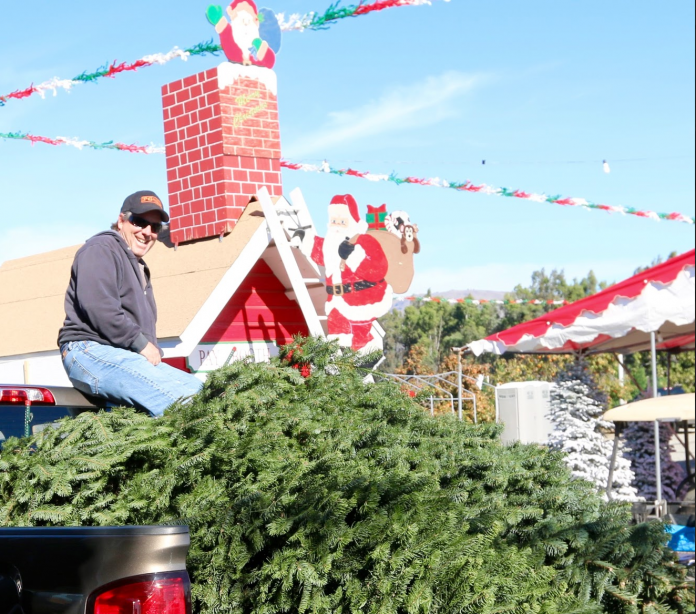The holiday season is no holiday for Ed Battaglia and his family—it’s the time they work the hardest.
They have a few weeks to make their livelihood selling thousands of Christmas trees from their San Martin ranch to people from all over South County and San Jose.
“It’s definitely seasonal,” says Battaglia, 69, who started selling trees while he was in high school in San Jose. “We have a big rush on Black Friday and it’s even bigger the weekend after. Then, we have a big rush the following weekend. Then, it dwindles down.”
How hard do they work? They don’t even have time to put up their own tree, a 7-foot-high Noble Fir, until just before Christmas. “We’re the last ones to put one up,” he says.
Battaglia and his family, including his brother Paul, and their wives, Pam and Shirley, grow 20 acres of trees in San Martin at 13580 Murphy Ave. and 150 acres in Oregon, which they haul down in big semi trucks daily, starting Nov. 20.
The first shipment was 1,400 Noble Firs. Trucks arrive every day for the next week-and- a-half. They also sell Monterey Pine and Leyland Cypress trees, grown here. The cypresses are said to be good for people with allergies, sort of a gluten-free tree. Battaglia says he has no proof of that, but it’s what he’s been told.
You can buy trees already cut or cut them down yourself. The trees sell for $6 a foot if you cut them, or starting at $59 already cut. The biggest trees are 14 feet tall, but most people buy them between 6 and 8 feet, living room sized.
“The best part of the job is seeing the families and the smiles on the kids’ faces. We have a snow machine at night and they look at the snow flakes coming down and their smiles light up. That’s what it’s all about—the families.”
The worst part?
“The hours and the weather,” he says. “We work from 8 in the morning until 10 at night. Most everyone else goes home but my brother, Paul my wife Pam and I close up.”
Last Saturday’s beautiful weather was a problem. He and some of his crew of 55 employees had to cover the trees with black plastic to protect them from the warm sun.
They’ve turned the lot into a kind of Christmas village, with Ed doing much of the work himself, a regular holiday Renaissance man. He built the reindeer train and paints the colorful buildings. He also designed and built some of the machines that prepare the trees before anyone gets there. One of them uses a hydraulic conveyor belt and a Honda engine to compress the branches and drill a hole in the bottom of the tree to allow it to mount firmly on the stands they sell.
The biggest selling items in their holiday store are plush toys, tree toppers, plush Santas, fluffy animals, gingerbread dolls, hot chocolate and hot cider. Santa visits on the weekends and the train runs on weekends and nights.
The Battaglia brothers started selling trees on Capitol Avenue in San Jose in 1967. Their father had a ranch that grew apricots, plums and prunes. He passed away young and Ed and Paul thought they could earn some extra money for clothes and books by selling trees. Their lot off I-680 did well and when they saw a bigger lot for sale in San Martin in 1997, they snapped it up.
They like the location by the freeway, which is like free advertising. Most customers are from South County and San Jose, but occasionally, they get a tourist from Los Angeles taking the long way home with a tree on board.
The strangest thing they’ve seen is families fighting while buying a tree. “We’ve seen husbands and wives slap each other around.” But they’ve also been surprised by carolers coming to the ranch to sing for the crowds. They’ll sell 1,000 trees the first day, and each tree comes with about four people, says Battaglia.
Battaglia invented the machines to silently drill holes in the tree bases to speed up the process and not ruin the atmosphere. When they were doing it by hand, it moved a lot more slowly. He also has saws for people to cut down trees and wheeled carts to bring them to their cars.
Ed works in real estate and taking care of the tree properties year round. It takes four years for the cypress and pine trees to grow in San Martin and seven years to grow a full-sized Noble Fir in Oregon. A tree will last three weeks, if it’s kept in water, he says. If you forget the water, it will die early.
About 20 percent of the trees he sells are flocked white, with a substance that is a mix of liquified paper and adhesive. He gets requests for Charlie Brown-like sad little trees, and yes, he has some. He also has half-trees and corner trees—trees with the backs cut off so they fit up against a wall or in a corner.
“No one sees the back,” he says.
The Battaglia’s kids, who have full-time jobs, have no interest in taking over the business, Ed says. “They make more doing full-time work. This is seasonal. It’s a tough business.”















